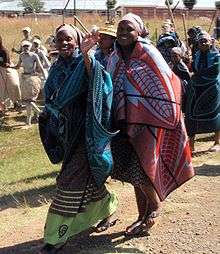Basotho blanket
The Basotho blanket (Seana Marena) is a distinctive form of woollen tribal blanket traditionally worn by Sotho people and unique to the Kingdom of Lesotho.[1] Originally gifted to the then ruler King Moshoeshoe I by a British man known only as "Mr Howell" in the late 19th century,[2] these blankets quickly gained popularity in the Lesotho region.


The way that Lesotho men wear these traditional blankets is founded on the traditional Kaross, an animal skin cape, although their transformation to "factory-woven textile" is attributed to King Moshoeshoe I.[3] By 1860 securing sufficient skins for Karosses was increasingly difficult and by 1872 a large majority of sheepskin covers had been replaced by poor quality cotton or wool.[4] The King secured the production of "special blankets" in 1876 after meeting with Scottish textile manufacturer Donald Fraser. These new blankets were not only sturdier but they could also be fashioned in a way which more resembled the Kaross and they therefore quickly replaced the poor quality imported cloth that the people of Lesotho were previously wearing.
Ceremonial use
Across the kingdom, a variety of these blankets are worn by the people of Lesotho to represent the different rites of passage in society.
The Moholobela is a fertility blanket worn by young Sotho men in preparation of their transition to manhood. After the initiation ceremony, the young men in Lesotho will don a different blanket known as the Lekhokolo, which confirms that they have reached adulthood.
In preparation for the wedding ceremony, Lesotho women ordinarily wear a Motlotlehi blanket on their wedding day, they will traditionally gift their wife a Serope blanket when their first child is born.[5]
Seana Marena[6]: Means chief's blanket or to swear by the king: This particular blanket is exclusively worn by the king and his chiefs, it has the highest status of all Basotho blankets.
Lehlosi[7]: A Chiefly blanket made of patterns from the skin of wild cat or leopards. At present, one will often observe chiefs wearing commercially manufactured blankets bearing the print of a leopard, rather than actual leopard skins.
Victorian/ Malakabane[8]: In 1897 Queen Victoria visited the Lesotho during her inaugural year. She gave King Lerotholi a gift, which happened to be a blanket. He wore the blanket with elegance, in a manner that represented the Poncho, over his shoulders and there the blanket wearing tradition began. The blanket was named Victoria England. The Sotho people had a great love and respect for Queen Victoria and the Victoria England blanket has become a sought after status symbol.
Motlatsi[9]: designed and produced to pay tribute to the birth of Prince Lerotholi. Motlatsi means "successor".
Letlama[10]: worn by traditionally initiated men & women " tlama" is to tie "ke e tlametse mathata aseng basadi ba batho" ("I have tied (the blanket) for my own problems not for other men's wives') is what one who wears this particular blanket would say.
Lingoetsi[11]: a bride's blanket.
Batho Ba Roma[12]: remembering Pope John Paul’s visit to Lesotho in 1988.
Kharetsa[13]: named after the aloe which is indigenous to the Maloti Mountains of Lesotho.
Sefate and Morena[14]: are used by the Basotho people as an everyday wearing blanket.
Ketelo ea Morena Papa which means the visit of the Pope[15]: Pope John Paul II once had a visit to Lesotho in 1988, a blanket gift was given to him which has been placed in the Vatican in Rome.[16]
Controversy
Louis Vuitton's designs for the 2017 menswear collection featured designs from Basotho Blankets which caused controversy in South Africa with accusations of cultural appropriation.[17]
In popular media
In the 2018 films Black Panther and in Avengers: Infinity Wars, W’Kabi and his tribesmen appear in many scenes wearing what looks like the Basotho blanket. Given that the actors in the film were not from Continental Africa, several continental African groups viewed the appropriation of these cultural symbols as inappropriate for use by diasporic Africans.[18] The movie however brought the blankets to international attention and an increase in sales.[19]
See also
- Specific visual symbols related to the coming of age ceremony lebollo la basadi
- Lebollo la banna
References
- "The History of the Basotho traditional blanket". The Blanket Wrap. 2010-11-01. Retrieved 2017-09-23.
- Pierce, Thom (2016-10-17). "Riding the southern wilds: the horsemen of Lesotho – in pictures". the Guardian. Retrieved 2017-09-23.
- Christopher., Spring (2012). African textiles today. London: The British Museum Press ; [Washington, DC] : Smithsonian Books, in association with British Museum Press. ISBN 9780714115597. OCLC 793219855.
- "The History of the Basotho traditional blanket". The Blanket Wrap. 2010-11-01. Retrieved 2017-09-23.
- "The power of the seannamarena". Mzansi Magic Official Website - The power of the seannamarena. Retrieved 2017-09-23.
- Myrtle Karstel, Culna, Volume 1991, Issue 41, Oct 1991, p. 25 – 26
- https://www.wantedonline.co.za/art-design/2017-02-01-how-the-basotho-blanket-became-the-brand-identity-of-a-nation/
- https://www.wantedonline.co.za/art-design/2017-02-01-how-the-basotho-blanket-became-the-brand-identity-of-a-nation/
- https://www.wantedonline.co.za/art-design/2017-02-01-how-the-basotho-blanket-became-the-brand-identity-of-a-nation/
- HOUSE&OF&THE&CROCODILE: SOUTH SOTHO ART AND HISTORY IN SOUTHERNAFRICA, David Matthew Merkel Riep, University of Iowa, May 2011
- https://africa.uima.uiowa.edu/topic-essays/show/43?start=0
- HOUSE&OF&THE&CROCODILE: SOUTH SOTHO ART AND HISTORY IN SOUTHERNAFRICA, David Matthew Merkel Riep, University of Iowa, May 2011
- HOUSE&OF&THE&CROCODILE: SOUTH SOTHO ART AND HISTORY IN SOUTHERNAFRICA, David Matthew Merkel Riep, University of Iowa, May 2011
- HOUSE&OF&THE&CROCODILE: SOUTH SOTHO ART AND HISTORY IN SOUTHERNAFRICA, David Matthew Merkel Riep, University of Iowa, May 2011
- Lebollo la basadi
- Myrtle Karstel, Culna, Volume 1991, Issue 41, Oct 1991, p. 25 – 26
- "Fab or cultural faux pas? Louis Vuitton's Basotho blanket-inspired collection". Retrieved 2017-09-23.
- http://afropunk.com/2018/02/controversy-around-black-panthers-supposed-appropriation-shows-necessity-pan-africanism/
- https://www.businessinsider.co.za/black-panther-has-not-real-effect-on-the-south-african-sale-of-basotho-blankts-2018-3
External links
![]()